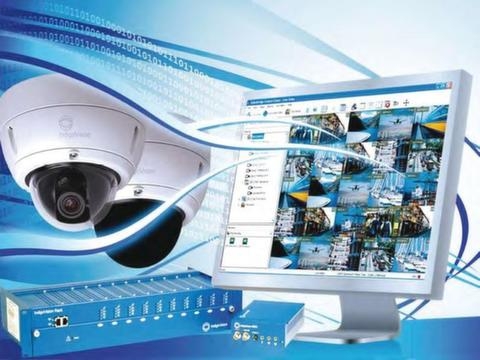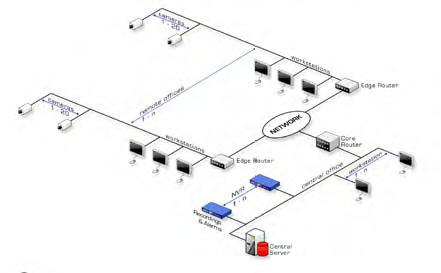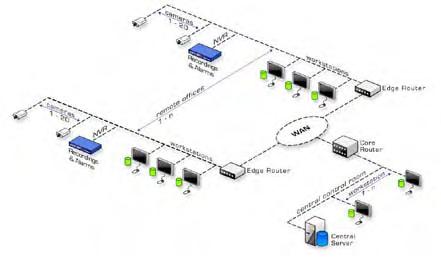This article discusses the serious scalability problems which arise when an IP-CCTV system is based on a Centralised Architecture and how a Distributed Architecture delivers a flexible and scalable solution than can lead to systems being deployed across sites, cities and countries.
Storing IP Video Data
There are typically two different approaches to storing data in an IP Video system. A centralised architectureuses a master database usually located in the central control room or head office. A distributed architecturespreads the data around the Security Management system generally keeping it close to where it is produced or needed.
The stored data can be categorised into two types - Configuration and Live.
Configuration data is site information specifying the design and make-up of the Security Management system. Examples of configuration data include lists of cameras, lists of users, user permissions, site structure, maps representing the layout of the system and licensing information. After the initial installation and commissioning stages of a Security Management system, configuration data is not routinely changed. It is however routinely accessed by operators e.g. when logging in to the system.
Live data is typically CCTV video recordings and alarm information. Live data is accessed continuously during normal Security Management operations, either by devices recording the data or operators reviewing the data.
Configuration data is usually held in a database called the Site Database. This makes it easy for administrators to make and manage changes; however it also creates a problem. When an administrator makes a change to the Site Database how do the users, distributed throughout the Security Management system, get the change?
The obvious and easy solution is to have the Site Database held centrally on a master database server and have all users access the master server over the network. This is called a centralised architecture.
Many systems use a centralised architecture for storing more than just configuration data. They may also use it for storing live data such as video recordings or alarm data.
Centralised Architecture
Figure 1 shows a Security Management system consisting of one or more sites each with its own Local Area Network (LAN) connected to a central office. The central office is also where the Central File Server is located, hosting the Site Database. Also in the central office are Network Video Recorders (NVRs) for recording CCTV video and alarm data.
Every camera and workstation in each remote office must regularly, and in some cases continuously, communicate with the central office in order to check for changes and updates in the Site Database. This includes checking for valid licenses or storing recording and alarm data.
A centralised architecture causes four major problems:
1. Cost- All users continuously communicate with the central office. On a LAN that means buying expensive high-end switches and on a Wide Area Network (WAN) it means using up precious bandwidth.
2. Reliability and Resilience- What happens when the WAN or core LAN switch breaks? Remote users can be left stranded with no access to the live and recorded video from cameras which are actually located locally to them on a working LAN.
3. Single point of failure- What happens if the server hosting the Site Database fails? All users of the system rely on access to the Site Database. For example, to get login credentials verified or license permissions checked. If the Site Database server fails, the whole Security Management system goes down.
4. Scalability- As more cameras and users get added to each remote office and as more remote offices get added to the network, everything gets congested. The local LAN’s, WAN links and Central Server all get congested coping with increasing levels of traffic checking for Site Database changes, valid licensing and storing recordings and alarms.
Distributed Architecture
Figure 2 shows how the same Security Management network can be constructed using distributed databases.
Distributing Configuration Data
To distribute configuration data, each remote workstation can keep a local cache of the Site Database. Configuration data does not change very frequently. This means the information can be synchronised between the Central Server and the remote workstations either according to a managed schedule or on-demand when a change happens.
In the event that the Central Server, a core LAN switch or the WAN fails, users at workstations can continue to work using their locally cached Site Database.
Distributing Licensing Data
Rather than holding licence information centrally in the Central Server, individual components of the Security Management system can hold their own licenses. For example, cameras can hold information in their on-board memory about allowed viewing and recording resolutions, or allowed frame rates. They can also hold information on which features are enabled such as advanced motion analytics.
Such a model, where the sources of the valuable data (the cameras and recorders) contain their own licences, means that the cameras and recorders never need to talk to the Central Server. Because the data sources have their own distributed licenses, this frees up the data viewing applications, running on each workstation, from requiring any license at all. An operator can’t view video if the camera or recorder won’t let him. This means none of the workstations need to check licensing conditions with the Central Server.
Distributing Live Data
Rather than continuously streaming recording and alarm data back from the remote sites to the central site across the WAN, it would be much better to keep the data locally on the LAN. One or more local NVRs at each remote site would reduce traffic across the WAN and allow users at the remote sites to access recordings and alarms even when the WAN is not available.
Of course the central office is often where alarm management happens across the whole Security Management system so users in the central office can still access the remote NVRs in the event of an alarm or incident investigation. Usually when this happens they only need to playback or export certain portions of video from certain cameras and don’t need to access the full 24x7 recordings that have been made of all cameras at the remote site.
Less then 0.1% of video ever gets looked at, so why waste valuable WAN bandwidth unnecessarily? Just use the WAN to restore the pertinent recorded video data when required.
Solving the Problems of a Centralised Architecture
The four major problems associated with a centralised architecture are overcome with a distributed architecture:
1. Cost- Precious WAN bandwidth is not used for continuous communication with all remote devices. Instead configuration data is distributed in a managed way. In the event of an operational incident, only the live CCTV video that is required needs be streamed across the WAN or extended LAN. The need to check license data across the network is removed entirely. Cost-effective core network switches can be specified to cope with reduced network loads.
2. Reliability and Resilience- A potential source of failure in the Security Management network is the WAN. Money can be spent on increasing the reliability of the WAN connections but it is much more effective to distribute the data so that users still have a working Security Management system even if the WAN connections fail.
3. Single Point of failure- Another source of failure in a Security Management system is the data stores – either the Central Server hosting the Site Database or the recorders. Again, money can be spent on increasing the power and reliability of those machines but it is much more effective to distribute the data stores so that users still have a working Security Management system even if those components fail.
4. Scalability- With a distributed architecture additional cameras and users can be added to a local office with minimal increase in WAN traffic, the video is streamed and recorded locally. Similarly, if another remote office is added it is just a duplicate of existing offices with local LAN and storage. For even larger systems multiple Central Servers can be distributed and synchronised adding yet another layer of distribution and resilience.
Summary
System designers and end-users should ensure that when choosing an IP Video platform for their security system it is based on a distributed solution, otherwise the lack of scalability may hinder future expansion and the single point of failure could lead to unreliable operation.





